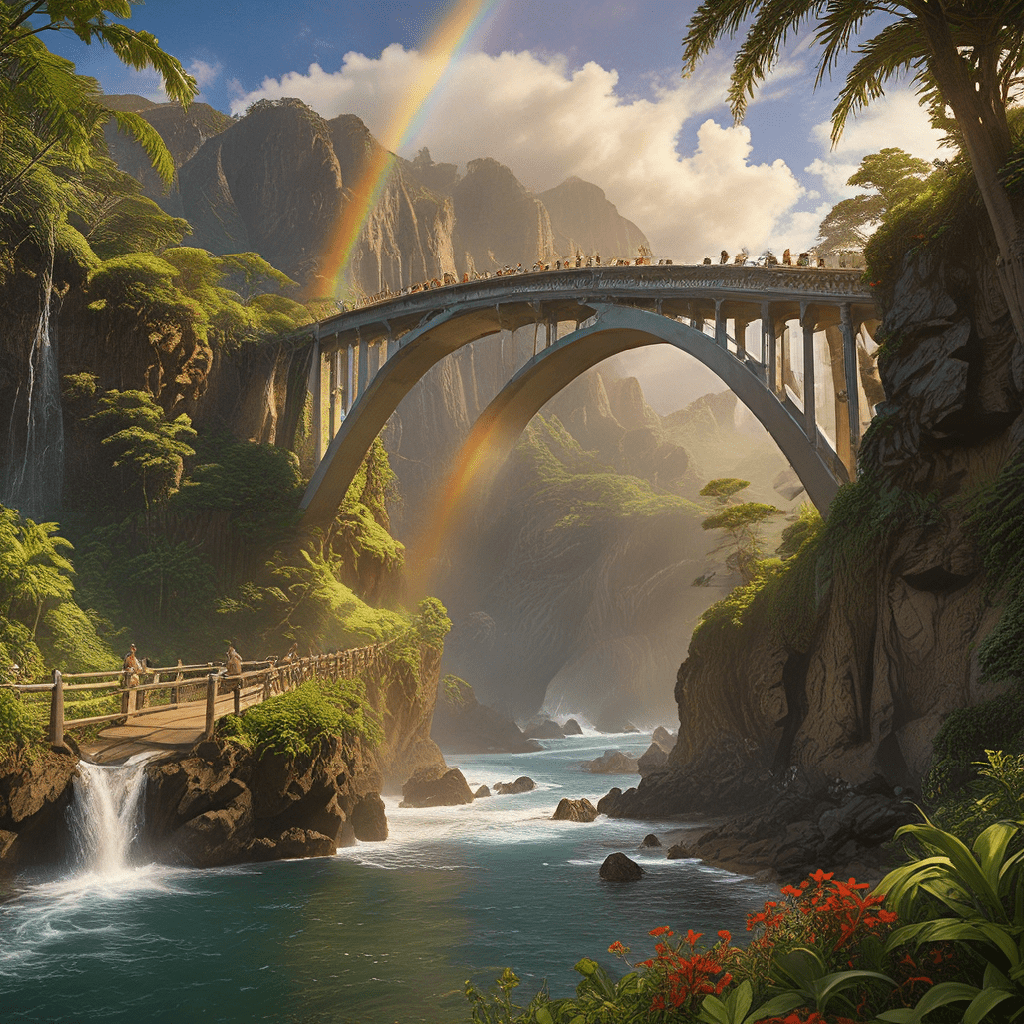The Rainbow Bridge: A Gateway to the Afterlife
In the rich tapestry of Hawaiian folklore, the Rainbow Bridge, known as "A‘a Noho" or "A‘a Noho I Ka Lani," holds a profound and mystical significance. This celestial bridge, woven from vibrant rainbows, is believed to serve as a sacred passage between the earthly realm and the celestial abode of the gods, known as "Ka Lani." According to Hawaiian mythology, rainbows are not merely beautiful atmospheric phenomena but tangible pathways, connecting the human world to the divine realm. As a gateway to the afterlife, the Rainbow Bridge is a powerful symbol of transition, renewal, and the eternal cycle of life and death.
A Sacred Bridge Connecting Heaven and Earth
The Rainbow Bridge is not just a bridge in the literal sense but rather a cosmic connection, a bridge of light and energy that transcends the physical boundaries of our world. It is believed to be a sacred pathway for the souls of the deceased as they ascend to the celestial realm, guided by the gods and ancestors who reside there. The rainbow, with its spectrum of colors, represents the vibrant energy of the divine realm, illuminating the path for the departed.
The Legend of the Rainbow Bridge: A Journey to the Other Side
The legend of the Rainbow Bridge is deeply entwined with the belief in the "Akua," the gods and goddesses who govern the natural world and human destiny. When a person passes away, their spirit is believed to embark on a journey across the Rainbow Bridge, guided by the "Akua" and their ancestors. This journey is often described as being peaceful and filled with light, representing the transition from the earthly realm to the celestial realm. Along the way, the spirits encounter their deceased loved ones, who welcome them to the afterlife with open arms.
The Rainbow Bridge in Hawaiian Cosmology
The Rainbow Bridge plays a crucial role in Hawaiian cosmology, the intricate system of beliefs and stories that explain the origin and functioning of the universe. It is believed to be one of the most sacred and powerful symbols in Hawaiian mythology, bridging the gap between the terrestrial and celestial realms. The Rainbow Bridge is a tangible representation of the interconnectedness of all things, both physical and spiritual. It serves as a reminder that the cycle of life and death is not an end but a continuous journey, a transition from one realm to another.
A Bridge for the Souls of the Deceased
The Rainbow Bridge is not just a pathway for the souls of the departed but also a place of reunion and solace. It is believed to be a place where loved ones who have passed on can greet and comfort those who are still living. The rainbow, with its radiant hues, symbolizes the hope and joy of reuniting with loved ones who have crossed over. The bridge represents a place of peace and tranquility, where souls can find solace and comfort in the presence of the divine.
The Role of the Rainbow Bridge in Hawaiian Burial Practices
The Rainbow Bridge is deeply intertwined with the traditional burial practices of the Hawaiian people. When a loved one passed away, their bodies were often placed in sacred burial grounds known as "heiau" or "papa he'e." These burial sites were often situated near the coast or in locations associated with the Rainbow Bridge. The Hawaiian people believed that the spirits of the deceased would ascend to the celestial realm via the Rainbow Bridge, making these burial sites a place of connection between the living and the departed.
The act of placing a person's remains in a sacred burial ground was not merely a practical act but a symbolic ritual, signifying the passage of the spirit to the afterlife. The location of the burial, often chosen with the Rainbow Bridge in mind, served as a powerful reminder of the connection between the physical and spiritual realms. The presence of the Rainbow Bridge in these burial practices underscored the belief in the continuous journey of the soul, a journey that transcended the boundaries of life and death.
The Rainbow Bridge: A Symbol of Hope and Renewal
The Rainbow Bridge is not only a pathway for the departed but also a symbol of hope and renewal for those who remain behind. The vibrant colors of the rainbow represent the beauty and promise of a new beginning, a reminder that life continues even in the face of death. The bridge symbolizes the possibility of reuniting with loved ones in the afterlife, offering solace and comfort to those who grieve. The Rainbow Bridge serves as a beacon of hope, reminding people that death is not an ending but a transition, a journey to a new realm where life continues in a different form.
Theories Behind the Rainbow Bridge Legend
The Rainbow Bridge legend, like many myths and legends, has its roots in both cultural beliefs and the observation of natural phenomena. The rainbow, with its dazzling array of colors, has been a source of wonder and fascination throughout human history. In many cultures, rainbows are associated with the gods, with divine messengers, or with the transition between life and death.
In the case of the Rainbow Bridge, the legend may have arisen from the observation of rainbows appearing over the ocean, particularly after rain storms. This natural phenomenon would have been particularly striking to the ancient Hawaiians, who lived in close proximity to the ocean and were deeply connected to its rhythms. The rainbows, appearing over the vast expanse of the ocean, may have been seen as pathways leading to a realm beyond the horizon, a place of mystery and wonder.
Natural Phenomena and the Rainbow Bridge
The Rainbow Bridge legend is not only a product of cultural beliefs but also a testament to the power of natural phenomena to inspire stories and myths. The rainbow, with its captivating appearance, has long been a source of wonder and fascination for people around the world. In Hawaiian culture, the rainbow is an important symbol, representing the interconnectedness of the physical and spiritual realms. The Rainbow Bridge legend, with its emphasis on the transition between life and death, may reflect the way in which the ancient Hawaiians viewed the natural world, seeing it as a canvas for stories and symbols that connected them to the divine.
The Rainbow Bridge: A Metaphor for the Journey of Life
Beyond its literal interpretation as a pathway to the afterlife, the Rainbow Bridge can also be seen as a metaphor for the journey of life itself. The bridge, with its arching form, represents the challenges and obstacles that we face along the way. The vibrant colors of the rainbow symbolize the joys, sorrows, and experiences that shape our lives. The journey across the Rainbow Bridge is a metaphor for the ongoing process of growth and transformation, a reminder that life is a continuous journey of discovery and learning.
FAQ
Q: What is the Rainbow Bridge?
A: The Rainbow Bridge, known as "A‘a Noho" or "A‘a Noho I Ka Lani," is a sacred bridge in Hawaiian folklore. It is believed to be a pathway between the earthly realm and the celestial abode of the gods.
Q: What is the significance of the Rainbow Bridge in Hawaiian culture?
A: The Rainbow Bridge is a powerful symbol of transition, renewal, and the eternal cycle of life and death. It is a gateway for the souls of the deceased as they ascend to the celestial realm.
Q: How is the Rainbow Bridge connected to Hawaiian burial practices?
A: The Rainbow Bridge is closely associated with traditional burial practices. The location of burial sites, often near the coast or in locations associated with the Rainbow Bridge, reflected a belief that the spirits of the deceased would ascend to the afterlife via the bridge.
Q: What are some theories about the origins of the Rainbow Bridge legend?
A: Theories about the origins of the legend include the observation of rainbows appearing over the ocean, a connection to the natural phenomenon as a pathway to a realm beyond the horizon, and a reflection of the ancient Hawaiians’ deep connection to the natural world.
Q: What is the metaphorical meaning of the Rainbow Bridge?
A: The Rainbow Bridge is also a metaphor for the journey of life itself. The bridge, with its arching form, represents challenges and obstacles, while the colors symbolize the joys, sorrows, and experiences that shape our lives.



